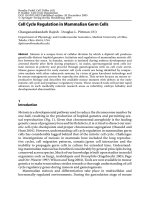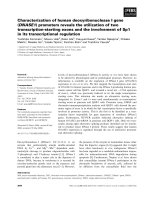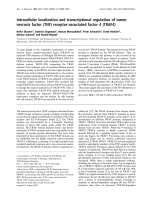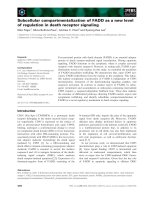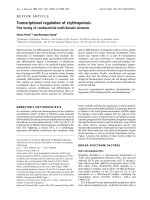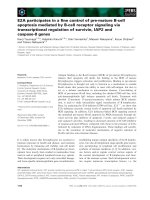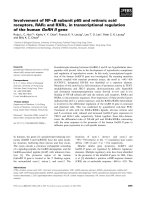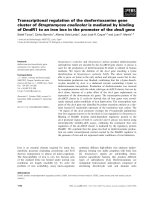transcriptional regulation in eukaryotes
Bạn đang xem bản rút gọn của tài liệu. Xem và tải ngay bản đầy đủ của tài liệu tại đây (7.89 MB, 671 trang )
Transcriptional
Regulation
in Eukaryotes
Concepts, Strategies, and Techniques
C
OLD
S
PRING
H
ARBOR
L
ABORATORY
P
RESS
Michael Carey
Stephen T. Smale
Transcriptional
Regulation
in Eukaryotes
Concepts, Strategies, and Techniques
Stephen T. Smale
Howard Hughes Medical Institute and
University of California, Los Angeles
Michael Carey
University of California,
Los Angeles
Cover illustration: The cover schematically illustrates the structure of the RNA polymerase II transcription
complex emerging from a black box. It is a composite illustration of the TFIIA-TBP-TATA (Geiger et al. Science
272: 830–836 [1996]; Tan et al. Nature 381: 127–151 [1996]), and TFIIB-TBP-TATA (Nikolov et al. Nature 377:
119–128 [1995]) crystal structures rendered by Michael Haykinson (UCLA) using the Molecular Graphics
structure modeling computer program Insight II.
Library of Congress Cataloging-in-Publication Data
Carey, Michael (Michael F.)
Transcriptional regulation in eukaryotes: concepts, strategies, and techniques/Michael
Carey, Stephen T. Smale.
p. cm.
Includes bibliographical references and index.
ISBN 0-87969-537-4 (cloth) ISBN 0-87969-635-4 (pbk.)
1. Genetic transcription Regulation. 2. Transcription factors. 3. Genetic
transcription Regulation Research Methodology. I. Smale T. II. Title.
QH450.2.C375 1999
572.8´845 dc21 99-049636
10 9 8 7 6 5 4 3
Students and researchers using the procedures in this manual do so at their own risk. Cold Spring Harbor
Laboratory makes no representations or warranties with respect to the material set forth in this manual and
has no liability in connection with the use of these materials.
Procedures for the humane treatment of animals must be observed at all times. Check with the local animal
facility for guidelines.
Certain experimental procedures in this manual may be the subject of national or local legislation or agency
restrictions. Users of this manual are responsible for obtaining the relevant permissions, certificates, or licens-
es in these cases. Neither the authors of this manual nor Cold Spring Harbor Laboratory assumes any respon-
sibility for failure of a user to do so.
The polymerase chain reaction process is covered by certain patent and proprietary rights. Users of this man-
ual are responsible for obtaining any licenses necessary to practice PCR or to commercialize the results of such
use. COLD SPRING HARBOR LABORATORY MAKES NO REPRESENTATION THAT USE OF THE INFOR-
MATION IN THIS MANUAL WILL NOT INFRINGE ANY PATENT OR OTHER PROPRIETARY RIGHT.
Authorization to photocopy items for internal or personal use, or the internal or personal use of specific clients,
is granted by Cold Spring Harbor Laboratory Press, provided that the appropriate fee is paid directly to the
Copyright Clearance Center (CCC). Write or call CCC at 222 Rosewood Drive, Danvers, MA 01923 (978-750-
8400) for information about fees and regulations. Prior to photocopying items for educational classroom use,
contact CCC at the above address. Additional information on CCC can be obtained at CCC Online at
/>All Cold Spring Harbor Laboratory Press publications may be ordered directly from Cold Spring Harbor
Laboratory Press, 500 Sunnyside Boulevard, Woodbury, New York 11797-2924. Phone: 1-800-843-4388 in
Continental U.S. and Canada. All other locations: (516) 422-4100. FAX: (516) 422-4097. E-mail:
For a complete catalog of all Cold Spring Harbor Laboratory Press publications, visit our
World Wide Web Site />Developmental Editor: Judy Cuddihy
Assistant Developmental Editor: Birgit Woelker
Project Coordinator: Maryliz M. Dickerson
Production Editor: Patricia Barker
Desktop Editors: Danny deBruin, Susan Schaefer
Interior Book Design: Denise Weiss
Cover Design: Tony Ur g o
Cover art rendered by Michael Haykinson
Transcriptional Regulation in Eukaryotes
Concepts, Strategies, and Techniques
All rights reserved
© 2000 Cold Spring Harbor Laboratory Press, Cold Spring Harbor, New York
Printed in the United States of America
Contents
Preface, xvii
Overview, xix
Abbreviations and Acronyms, xxv
1 A PRIMER ON TRANSCRIPTIONAL REGULATION IN MAMMALIAN CELLS
1
INTRODUCTION 2
A general model for regulation of a gene 2
Activating a gene, 3
Inactivating a gene, 5
Overview 5
CONCEPTS AND STRATEGIES: I. PROMOTERS AND THE GENERAL
TRANSCRIPTION MACHINERY
5
Core promoter architecture 8
The general transcription machinery 10
Basal transcription complex assembly, 11
Conformational changes during transcription complex assembly, 11
TAF
II
s 12
The holoenzyme and mediators 14
Discovery of the Pol II holoenzyme, 14
Composition of the yeast holoenzyme, 15
Mammalian holoenzymes, 16
CONCEPTS AND STRATEGIES: II. ACTIVATORS AND REPRESSORS
18
Regulatory promoters and enhancers 18
Transcriptional activators 20
Modular activators, 20
DNA-binding domains, 21
Activation domains, 21
Structural aspects of activation domains, 22
Repressors and corepressors 23
General mechanisms, 23
Sequence-specific repressors, 24
CONCEPTS AND STRATEGIES: III. CHROMATIN AND
GENE REGULATION
25
Chromatin 25
Structure and organization, 25
Binding of transcription factors to chromatin, 26
v
Genetic links between gene activation and chromatin, 27
ATP-dependent remodeling complexes 27
SWI/SNF complexes, 27
Mechanisms and targeting, 29
Acetylation of chromatin 31
Mammalian acetylases, 32
TAFs and chromatin remodeling, 32
Histone deacetylation, transcriptional repression, and silencing 32
Repression and deacetylases, 33
Linking deacetylation and ATP-remodeling machines, 33
Methylation and repression, 34
Transcriptional silencing, 35
Locus control regions, insulators, and matrix attachment regions 35
Locus control regions, 35
Boundary elements, 37
MARs, 38
CONCEPTS AND STRATEGIES: IV. THE ENHANCEOSOME
38
Combinatorial control, cooperativity, and synergy 38
The enhanceosome theory 39
The interferon-β enhanceosome 40
Biochemical mechanism of activation 41
Perspective 42
2 INITIAL STRATEGIC ISSUES 51
INTRODUCTION 52
CONCEPTS AND STRATEGIES
52
The initial steps in a gene regulation analysis 52
Consider the time commitment and resources needed
to reach a defined goal 54
Two general strategies that provide preliminary albeit superficial
insight into transcriptional regulation mechanisms, 54
An example of a rigorous, yet incomplete gene regulation analysis:
The immunoglobulin µ heavy-chain gene, 55
Defining the project goals, 57
Evaluate the feasibility of the analysis 57
Appropriate source of cells for functional studies, 57
Source of cells for protein extract preparation, 59
Success in developing an appropriate functional assay, 59
Initiate an analysis of transcriptional regulation 61
Beginning with the promoter or distant control regions, 61
Initiating an analysis of a promoter, 62
Initiating an analysis of distant control regions, 62
Summary 62
vi ■ Contents
3 MODES OF REGULATING mRNA ABUNDANCE 65
INTRODUCTION 66
CONCEPTS AND STRATEGIES 66
Transcription initiation versus mRNA stability 66
Basic mRNA degradation pathways, 67
Regulation of mRNA stability and degradation, 68
Interrelationship between mRNA stability and transcription initiation, 70
Confirming that the rate of transcription initiation
contributes to gene regulation, 71
Nuclear run-on transcription assay (Box 3.1), 72
Measuring mRNA stabilities, 73
Recommended approach for demonstrating regulation of
transcription initiation or mRNA stability, 77
Transcription elongation 78
Basic mechanism of elongation, 78
Regulation of transcription elongation in prokaryotes, 79
Regulation of transcription elongation in eukaryotes, 80
Strategies for distinguishing between regulation of elongation and
regulation of initiation, 82
Recommended approach for demonstrating regulation
of transcription initiation or elongation, 83
Extending an analysis of elongation regulation, 84
Differential pre-mRNA splicing, mRNA transport, and polyadenylation 85
Basic principles, 85
Identifying regulation of pre-mRNA splicing, transport,
and polyadenylation, 86
TECHNIQUES
87
Protocol 3.1 Nuclear run-on assay 87
4 TRANSCRIPTION INITIATION SITE MAPPING 97
INTRODUCTION 98
CONCEPTS AND STRATEGIES 99
Initial considerations 99
Reagents needed before proceeding, 99
Information provided by the DNA sequence, 99
Primer extension 102
Advantages and disadvantages, 102
Design of oligonucleotide primers, 102
Method (Box 4.1), 103
Primer annealing and reverse transcription, 104
Analysis of example data, 104
Contents ■ vii
RNase protection 105
Advantages and disadvantages, 105
Probe preparation, 105
Method (Box 4.2), 106
Probe annealing and RNase digestion, 108
Analysis of example data, 108
S1 nuclease analysis 109
Advantages and disadvantages, 109
Probe preparation, 109
Method (Box 4.3), 109
Analysis of example data, 111
Rapid amplification of cDNA ends 112
Advantages and disadvantages, 112
Data analysis, 112
Method (Box 4.4), 112
Effect of introns on the interpretation of start-site mapping results
(Box 4.5), 114
TECHNIQUES
116
Protocol 4.1 Primer extension assay 116
Protocol 4.2 RNase protection assay 124
Protocol 4.3 S1 nuclease assay 130
5 FUNCTIONAL ASSAYS FOR PROMOTER ANALYSIS
137
INTRODUCTION 138
CONCEPTS AND STRATEGIES
141
Choosing an assay: Advantages and disadvantages of each assay 141
Transient transfection assay, 142
Stable transfection assay by integration into host chromosome, 144
Stable transfection of episomally maintained plasmids, 145
In vitro transcription assay, 145
Transgenic assays, 146
Homologous recombination assay, 147
Transient transfection assays 147
Cells, 148
Transfection procedures (Box 5.1), 148
Reporter genes, vectors, and assays (Boxes 5.2, 5.3, 5.4), 150
Plasmid construction, 155
Initial transfection experiments, 157
Assessing appropriate promoter regulation (Boxes 5.5, 5.6), 159
Stable transfection assays by chromosomal integration 160
General strategies, 160
Cells and transfection procedures, 162
viii ■ Contents
Reporter genes and assays, 165
Drug-resistance genes and vectors, 165
Plasmid construction, 168
Drug selection, 169
Controls and interpretation of results, 171
TECHNIQUES
172
Common transfection methods for mammalian cells 172
Protocol 5.1 Calcium phosphate transfection of 3T3 fibroblasts 174
Protocol 5.2 DEAE-dextran transfection of lymphocyte cell lines 176
Protocol 5.3 Transfection by electroporation of RAW264.7 macrophages 178
Common reporter enzyme assays 180
Protocol 5.4 Luciferase assay 181
Protocol 5.5 Chloramphenicol acetyltransferase assay 183
Protocol 5.6 β-Galactosidase assay 186
6 IDENTIFICATION AND ANALYSIS OF DISTANT CONTROL REGIONS
193
INTRODUCTION 194
CONCEPTS AND STRATEGIES 195
DNase I hypersensitivity 195
Basic principles of DNase I sensitivity and hypersensitivity, 195
Advantages and disadvantages of using DNase I
hypersensitivity to identify control regions, 197
DNase I hypersensitivity assay (Box 6.1), 198
Data interpretation, 200
Identification of matrix attachment regions 200
Basic principles of the nuclear matrix and of MARs and SARs, 200
Advantages and disadvantages of using MARs to identify
distant control regions, 200
Methods for identifying MARs (Box 6.2), 201
Functional approaches for the identification of distant control regions 201
Basic advantages and disadvantages of functional approaches, 201
Functional approach beginning with a large genomic DNA fragment, 203
Functional approach beginning with smaller fragments directing
expression of a reporter gene, 204
Functional assays for the characterization of distant control regions 205
Transient transfection assays, 205
Stable transfection assays, 206
Demonstration of LCR activity, 208
Demonstration of silencer activity, 209
Demonstration of insulator activity, 209
Contents ■ ix
7 IDENTIFYING cis-ACTING DNA ELEMENTS WITHIN A CONTROL REGION 213
INTRODUCTION 214
CONCEPTS AND STRATEGIES 215
Identification of control elements by comprehensive mutant analysis 215
Rationale for a comprehensive analysis, 215
The Ig µ gene example, 216
Disadvantages of using mutagenesis to identify control elements, 219
Strategies for a comprehensive analysis, 220
Methodology for mutating a control region, 235
Identification of control elements using in vivo or in vitro
protein–DNA interaction methods 235
Advantages and disadvantages, 235
Identification of control elements by database analysis 237
Advantages and disadvantages, 237
Mutagenesis techniques (Boxes 7.1–7.6) 238
8 IDENTIFICATION OF DNA-BINDING PROTEINS AND ISOLATION OF THEIR GENES 249
INTRODUCTION 250
CONCEPTS AND STRATEGIES FOR THE IDENTIFICATION OF
DNA-BINDING PROTEINS
252
Database methods 252
Development of a protein-DNA interaction assay for crude cell lysates 253
Standard methods for detecting protein–DNA interactions, 253
Electrophoretic mobility shift assay (Box 8.1), 257
DNase I footprinting, 268
CONCEPTS AND STRATEGIES FOR CLONING GENES ENCODING
DNA-BINDING PROTEINS
272
Cloning by protein purification and peptide sequence analysis (Box 8.2) 276
Amount of starting material, 276
Conventional chromatography steps, 277
DNA affinity chromatography, 277
Identification of the relevant band following SDS-PAGE (Box 8.3), 278
Amino acid sequence analysis and gene cloning, 279
Confirmation that the gene isolated encodes the DNA-binding activity
of interest, 282
Cloning by methods that do not require an initial
protein–DNA interaction assay 283
One-hybrid screen, 283
In vitro expression library screening with DNA or antibody probes, 285
Mammalian expression cloning methods, 287
Genome database methods and degenerate PCR, 288
x ■ Contents
9 CONFIRMING THE FUNCTIONAL IMPORTANCE OF A
PROTEIN–DNA INTERACTION 291
INTRODUCTION 292
CONCEPTS AND STRATEGIES 294
Abundance of a protein–DNA complex in vitro 294
Relative expression patterns of the DNA-binding protein
and target gene 295
Correlation between nucleotides required for protein binding
and those required for activity of the control element 296
trans-Activation of a reporter gene or endogenous gene
by overexpression of the DNA-binding protein 297
Cooperative binding and synergistic function of
proteins bound to adjacent control elements 299
Comparison of genomic and in vitro footprinting patterns 301
Relative affinity of a protein–DNA interaction 302
Gene disruption or antisense experiments 304
Dominant-negative mutants 305
In vitro transcription strategies 308
In vivo protein–DNA crosslinking 310
Altered specificity experiments 313
10 IN VIVO ANALYSIS OF AN ENDOGENOUS CONTROL REGION 319
INTRODUCTION 320
CONCEPTS AND STRATEGIES 321
In vivo analysis of sequence-specific protein-DNA interactions 321
DNase I and DMS genomic footprinting (Box 10.1), 321
In vivo protein–DNA crosslinking/immunoprecipitation, 326
Nucleosome positioning and remodeling 326
Model systems, 326
Low-resolution analysis of nucleosome positioning by the
MNase-Southern blot method (Box 10.2), 328
High-resolution analysis of nucleosome positioning by an
MNase-LM-PCR method and DNase I genomic footprinting
(Box 10.3), 329
In vivo methods for analyzing nucleosome remodeling (Box 10.4), 332
DNA methylation 335
Subnuclear localization of a gene 337
TECHNIQUES
338
Protocol 10.1 MNase-Southern blot assay 338
Protocol 10.2 LM-PCR methods 347
DNase genomic footprinting, 347
MNase mapping of nucleosome positioning, 347
Contents ■ xi
Restriction enzyme accessibility to monitor nucleosome remodeling, 347
DMS genomic footprinting, 347
11 APPROACHES FOR THE SYNTHESIS OF RECOMBINANT TRANSCRIPTION FACTORS 365
INTRODUCTION 366
CONCEPTS AND STRATEGIES 367
Prokaryotic expression systems (Boxes 11.1 and 11.2) 367
Strategies for overcoming expression problems in E. coli 374
Synthesizing large regulatory proteins 377
Yeast systems (Box 11.3), 377
Baculovirus system (Box 11.4), 379
Vaccinia virus (Box 11.5), 382
Retroviral expression systems (Box 11.6), 384
Synthesizing small quantities of crude protein 385
Specialized inducible expression systems (Box 11.7), 386
In vitro transcription/translation systems (Box 11.8), 388
Mammalian expression vectors (Box 11.9), 389
Synthesis and purification of macromolecular complexes 390
Choosing an appropriate system 391
12 IDENTIFYING AND CHARACTERIZING TRANSCRIPTION FACTOR DOMAINS
399
INTRODUCTION 400
CONCEPTS AND STRATEGIES: DEFINING DOMAINS
400
Basic mutagenesis principles 400
Domains of a gene activator 402
Separating DNA-binding and activation domains of an activator 403
General considerations, 403
DNA binding, 404
Activation (Box 12.1), 406
Limitations of the domain swap, 406
Subdividing DNA recognition and oligomerization
subdomains (Box 12.2) 409
CONCEPTS AND STRATEGIES: PROTEIN–PROTEIN INTERACTIONS
410
Interaction of activation domains with coactivators and general factors 410
Affinity chromatography 413
Principles, 413
Caveats of the affinity approach, 415
Altered specificity genetic systems 416
Structure–function analysis of the general transcriptional machinery 420
TECHNIQUES
422
Protocol 12.1 PCR-mediated site-directed mutagenesis 422
xii ■ Contents
13 THEORY, CHARACTERIZATION, AND MODELING OF DNA BINDING BY
REGULATORY TRANSCRIPTION FACTORS 433
INTRODUCTION 434
CONCEPTS AND STRATEGIES 436
General theory and examples of DNA–protein interactions 436
Theory of DNA recognition, 436
Chemical basis of the interactions, 437
The role of the α-helix in DNA recognition, 437
Major and minor groove specificity, 439
Monomers and dimers; energetic and regulatory considerations, 441
Dissociation constant analysis (Box 13.1), 444
K
d
determination, 447
Analysis and modeling of DNA–protein interactions 448
Identification of a high-affinity DNA recognition site, 448
Basic theory, 449
General methods (Boxes 13.2 and 13.3), 449
Minor groove/DNA backbone probes (Box 13.4), 454
Major groove probes, 458
Modeling DNA–protein interactions, 459
Analysis of promoter-specific multicomponent nucleoprotein complexes 463
DNA binding cooperativity, 465
DNA looping and bending, 466
Mechanisms of DNA bending, 468
Approaches for studying bending, 469
TECHNIQUES
472
Protocol 13.1 DNase I footprinting 472
Protocol 13.2 Hydroxyl-radical footprinting 482
Protocol 13.3 Phosphate ethylation interference assay 485
Protocol 13.4 Methylation interference assay 488
Protocol 13.5 Electrophoretic mobility shift assays 493
Protocol 13.6 Preparation of
32
P-end-labeled DNA fragments 497
14 CRUDE AND FRACTIONATED SYSTEMS FOR IN VITRO TRANSCRIPTION 505
INTRODUCTION 506
CONCEPTS AND STRATEGIES 507
Preparation of extracts 507
Cell choice, 507
Extract preparation method, 508
Transcription assays 510
General considerations (Box 14.1), 510
Choice of template, 514
Chromatin systems, 516
Optimization of conditions, 519
Contents ■ xiii
Fractionated systems (Box 14.2) 519
Holoenzyme, 520
Mediator subcomplexes, 521
Partially fractionated systems, 521
Factor-depleted systems, 525
Highly fractionated systems, 526
TECHNIQUES
526
Preparation of nuclear and whole-cell extracts 526
Protocol 14.1 The Dignam and Roeder nuclear extract 528
Protocol 14.2 Preparation of nuclear extracts from rat liver 532
Protocol 14.3 Preparation of whole-cell extract 536
In vitro transcription assays 539
Protocol 14.4 In vitro transcription using HeLa cell extracts and
primer extension 539
Protocol 14.5 G-less cassette in vitro transcription using
HeLa cell nuclear extracts 545
Transcription factor purification 549
Protocol 14.6 Preparation of a crude fractionated system 551
Protocol 14.7 Purification of recombinant TFIIB from E. coli 556
Protocol 14.8 Purification of recombinant TFIIA 560
Protocol 14.9 Affinity purification of RNA Pol II 562
Protocol 14.10 Purification of epitope-tagged TFIID 567
15 APPROACHES FOR STUDYING TRANSCRIPTION COMPLEX ASSEMBLY 579
INTRODUCTION 580
CONCEPTS AND STRATEGIES 582
Formation of the basal preinitiation complex 582
Kinetic studies, 582
Sarkosyl probing, 582
Template commitment experiment, 584
DNase I footprinting and EMSA studies of transcription
complex assembly, 584
Photocrosslinking, 586
Structure–function analyses of the general machinery, 589
Open complex formation, initiation, and promoter escape 589
ATP-analogs and an energy-dependent step, 589
Permanganate probing, 590
Premelted templates, 590
The transition to elongation, 591
Assembly of activated complexes at a promoter 594
The immobilized template approach, 594
Gel filtration, 596
Permanganate probing to study activation, 596
xiv ■ Contents
EMSA and DNase I footprinting analyses of the TFIID–TFIIA complex, 599
Assembly and analysis of TFIID subcomplexes, 600
Future directions, 601
TECHNIQUES
603
Protocol 15.1 Potassium permanganate probing of Pol II open complexes 603
Protocol 15.2 Magnesium-agarose EMSA of TFIID binding to DNA 607
APPENDICES 617
I. CAUTIONS 617
II. SUPPLIERS 623
III. TRADEMARKS 625
INDEX 627
Contents ■ xv
Preface
Since the advent of recombinant DNA technology three decades ago, thousands of eukary-
otic genes have been isolated. The differential expression of these genes is critical for both
normal cellular processes and abnormal processes associated with disease. To understand
these processes, a growing number of investigators from diverse fields of biology have
begun to study the molecular mechanisms regulating gene transcription. Furthermore, the
genome projects under way throughout the world have led to the identification of the
entire gene complements of Saccharomyces cerevisiae, Caenorhabditis elegans, and numer-
ous archaeal and eubacterial organisms. Within the next few years, the approximately
100,000 genes within the human genome will have been identified. After this goal is real-
ized, the need to dissect mammalian transcriptional control regions and regulatory mech-
anisms rigorously will increase dramatically.
Despite the global interest in elucidating mechanisms of transcriptional regulation, a
comprehensive source of strategic, conceptual, and technical information has not been avail-
able for those entering the field for the first time. Although protocols for numerous tech-
niques have been published, the strategic decisions necessary to carry out a step-by-step
analysis have not been outlined. This deficiency became apparent to us while we were serv-
ing as instructors for the Eukaryotic Gene Expression course held each summer at Cold
Spring Harbor Laboratory. This laboratory course was designed for physician-scientists
interested in understanding the regulation of a specific disease-related gene, Ph.D. scientists
trained in other fields who became interested in the regulatory mechanisms for a gene
involved in a particular biological process, and graduate students or postdoctoral fellows who
were initiating transcriptional regulation projects. This book is targeted toward this same
diverse group of scientists who have developed an interest in transcriptional regulation.
In writing this book, we have focused on issues that the average investigator faces when
undertaking a transcriptional regulation analysis, and we have outlined recommended
strategies for completing the analysis. One risk of describing a prescribed step-by-step
approach is that it may suppress creativity and may not be applicable to all regulatory sce-
narios. To the contrary, our hope is that our recommendations will enhance creativity by
allowing it to evolve from an informed perspective.
We thank the many participants in the Eukaryotic Gene Expression Course from 1994
through 1998 for providing the inspiration and motivation for this book. We also acknowl-
edge our colleagues at UCLA, the members of our laboratories, and our co-instructors for
the Eukaryotic Gene Expression course, including Marc Learned, Ken Burtis, Grace Gill,
David Gilmour, and Jim Goodrich, for many valuable discussions. We are deeply indebted
to a number of colleagues for specific contributions and reading of sections, including
Doug Black, Mike Haykinson, Leila Hebshi, Reid Johnson, Ranjan Sen, and Amy
Weinmann. We are particularly grateful to our editor Judy Cuddihy and the book’s review-
ers, Grace Gill, Bill Tansey, and Steve Hahn, whose generous contribution of time and ideas
made the undertaking intellectually rewarding and personally enjoyable. The book was
greatly improved by the work of Birgit Woelker and Maryliz Dickerson at Cold Spring
Harbor Laboratory Press, as well as Jan Argentine, Pat Barker, and Denise Weiss. Finally, we
acknowledge Cold Spring Harbor Laboratory Press Director John Inglis, whose encour-
agement was essential for the completion of this novel project.
M.C. and S.T.S.
xviii ■ Preface
Overview
The goal of this book is to provide a detailed description of the approaches to be employed
and issues to be considered when undertaking a molecular analysis of the transcriptional
regulatory mechanisms for a newly isolated gene, or a biochemical analysis of a new tran-
scription factor. Our emphasis is on mammalian transcription, which is complicated by
the combinatorial nature of regulation and the lack of facile genetics. We refer periodical-
ly to studies in yeast, Drosophila, and other organisms where more tractable genetic
approaches have led to a detailed understanding of particular mechanistic issues. The top-
ics covered in the book extend from the determination of whether a gene is in fact regu-
lated at the level of transcription initiation to advanced strategies for characterizing the
biochemical mechanism underlying its combinatorial regulation by activators. Although
numerous specialized and detailed techniques are included, the unique characteristics of
this book are its strategic and conceptual emphasis on analysis of individual genes and the
transcription factors that regulate them.
Chapter 1 reviews the current state of the RNA polymerase II transcription field. This
chapter provides an investigator entering the field with a comprehensive introduction into
areas of active research and the types of regulatory strategies that will be confronted. We
have defined the general properties of known regulatory regions (i.e., enhancers, promot-
ers, silencers), components of the transcriptional machinery (mediator components and
the general transcription factors), activators, and repressors. Select review articles and on-
line information sources are included for the novice interested in additional details on the
various topics. Emphasis is placed on the role of macromolecular complexes in regulation.
Chapters 2–9 were conceived as a step-by-step guide for an investigator who wants to pur-
sue the regulatory mechanisms for a new gene that has been identified. Chapter 2 presents
general strategic issues to consider before the analysis is initiated. First and foremost is a dis-
cussion of the goals of the analysis. This topic was included because it has become apparent
that many investigators enter the transcription field with unrealistic expectations.
Presumably, these expectations arise because a preliminary analysis of a control region, using
basic reporter assays and electrophoretic mobility shift assays, is relatively straightforward. To
the contrary, a substantial amount of effort is usually required to make meaningful progress
toward an understanding of a gene’s regulatory mechanisms. Chapter 2 also contains a dis-
cussion of the feasibility of achieving the goals. The feasibility is largely dependent on the
availability of particular tools, including appropriate cell lines for functional and biochemi-
cal studies, and an appropriate functional assay. The chapter concludes with a discussion of
whether to begin the analysis by studying the promoter or, alternatively, distant control
regions, with a brief description of the initial steps required for each starting point. In this
book, the phrase “distant control regions” is used in reference to any control region that is
distinct from the promoter, such as enhancers, locus control regions, and silencers.
One issue that will become apparent in Chapter 2 and in all subsequent chapters is that
specific protocols are not included for many of the methods described. Instead, references
xix
are given to standard methods manuals, in particular Sambrook et al. (1989) and Ausubel
et al. (1994). The intention was to avoid duplication of the valuable information provided
in pre-existing manuals and to instead focus on strategic advice. Although the book could
have been written without any protocols, since they all can be found in the literature, we
chose to include selected protocols for three reasons. First, some of the protocols were cho-
sen because we felt that the reader would benefit from a detailed explanation of the spe-
cific steps and history of the methodology, information generally not found in other man-
uals. Second, in some instances we felt it necessary to provide the reader with a sense of the
mechanics of a technique while reading the book. Finally, several protocols were included
because of their special nature (e.g., permanganate footprinting, TFIID binding studies)
and the fact that no general source exists for such methods.
Chapter 3 continues the step-by-step guide by describing how to determine the mode
of regulation for a new gene. At the outset, this chapter emphasizes the fact that the regu-
lation of a biochemical activity does not necessarily mean that the gene encoding the pro-
tein is subject to regulation. Alternative possibilities are the regulation of protein synthesis
or degradation, or posttranslational regulation of the biochemical activity itself.
Furthermore, if the gene is found to be regulated, it is not necessarily regulated at the level
of transcription initiation. Rather, it may be regulated at the level of transcription elonga-
tion, mRNA stability, pre-mRNA splicing, polyadenylation, or mRNA transport. Because
regulation at the level of transcription initiation is most difficult to distinguish from regu-
lation of mRNA stability and transcription elongation, the basic principles of these latter
modes of regulation are discussed. Furthermore, strategies for distinguishing between the
various modes of regulation are presented, along with a detailed protocol for one impor-
tant technique, the nuclear run-on.
As stated above, one critical decision discussed in Chapter 2 is whether to begin an
analysis of transcriptional regulation by studying the promoter or, alternatively, the distant
control regions for the gene. If the investigator opts to study the promoter, the approach-
es detailed in Chapters 4 and 5 should be followed if the gene is found to be regulated at
the level of transcription initiation. Chapter 4 describes methods for determining the loca-
tion of the transcription start site, an essential first step in every promoter analysis. Four
methods for start-site mapping are described, including the primer extension, RNase pro-
tection, S1 nuclease, and RACE methods. The advantages and limitations of each method
are discussed, and detailed protocols are included for the first three.
Chapter 5 considers the development of a functional assay for a promoter; in other
words, the development of an assay that can be used to identify, by mutagenesis (see Chapter
7), the individual control elements required for promoter activity. Transient and stable
transfection assays are discussed in detail, including an overview of transfection procedures,
reporter genes, vectors, and assays, and the initial design and interpretation of experiments.
Alternative functional assays, including in vitro transcription and transgenic assays, are also
briefly mentioned, along with their advantages and disadvantages. Chapter 5 is the first of
several chapters where the text becomes strongly focused toward a discussion of transcrip-
tional activation, with very little discussion of transcriptional repression. The intention was
not to minimize the importance of repression mechanisms for transcriptional regulation;
however, a discussion of each point from the perspective of both activation and repression
would have been unmanageable. In most cases, it therefore is left to the reader to determine
how the principles discussed can be applied to a repression analysis.
If an investigator chooses to pursue distant control regions instead of, or in addition to,
the promoter, Chapters 5 and 6 are designed to follow Chapter 3. Chapter 5, as described
xx ■ Overview
above, contains basic information regarding the design of functional assays. This informa-
tion is applicable to both promoters and distant regions. Chapter 6 describes approaches for
identifying distal control regions, including the recommended starting point of performing
DNase I hypersensitivity experiments. Chapter 6 also describes special strategies not dis-
cussed in Chapter 5 for developing functional assays to analyze distant control regions.
After a functional assay is developed for a promoter (Chapters 4 and 5) or distant con-
trol region (Chapters 5 and 6), the next step is to dissect the individual DNA elements con-
stituting the region. These procedures, which usually involve a systematic mutant analysis,
are described in Chapter 7. This chapter stresses the benefits of a mutant analysis, but also
describes other strategies that may lead to the identification of important DNA elements
within a control region.
After the DNA elements are identified, the proteins that bind to them must be identi-
fied and their genes cloned. These procedures are described in Chapter 8, beginning with
the development of EMSA and DNase I footprinting assays for use with crude nuclear
extracts. These assays are discussed in greater detail in Chapter 13 from the perspective of
an analysis of a pure recombinant protein. An attempt was made to minimize the duplica-
tion of information between these two chapters. However, to maintain the logical progres-
sion of the book, some redundancy was unavoidable. Various strategies that can be used to
clone the gene encoding a DNA-binding protein are then described, including protein
purification, the yeast one-hybrid screen, in vitro expression library screen, mammalian
expression cloning, degenerate PCR, and database approaches.
Chapter 9 completes the step-by-step outline of the characterization of a new gene by
focusing on a crucial issue: After a factor that binds an important DNA element in vitro is
identified, how can one determine whether that factor is indeed responsible for the func-
tion of the control element in vivo? Although no experiment is available that can provide
conclusive evidence that the protein is functionally relevant, twelve experimental strategies
are described that can be used to test the hypothesis. As with all science, the strength of the
hypothesis will correspond to the number of rigorous tests to which it has been subjected.
The analysis of a control region, using the strategies described in Chapters 2–9, relies
on the use of artificial assays, such as transfection assays and in vitro DNA-binding assays.
To complement these approaches, it can be helpful to study the properties of the endoge-
nous control region within its natural environment. Chapter 10 describes experimental
strategies for such a characterization, beginning with genomic footprinting and in vivo
crosslinking/immunoprecipitation strategies for visualizing specific protein–DNA interac-
tions at the endogenous locus. Chromatin structure is also known to be an important con-
tributor to gene regulation and is best studied in the context of the endogenous locus.
Therefore, strategies are included for determining nucleosome positioning and remodel-
ing. Strategies for analyzing DNA methylation status and subnuclear localization of a gene
are also briefly discussed.
From a biochemical point of view, an understanding of the mechanism of gene regula-
tion involves recreating regulated transcription in vitro and delineating the precise pro-
tein–protein and protein–DNA interactions involved in the process. Chapters 11–15
describe approaches for recreating and studying gene regulation in vitro using purified and
reconstituted biochemical systems.
The initial starting point in a biochemical analysis of any regulatory protein is to syn-
thesize the protein and its derivatives in recombinant form. Chapter 11 provides a list of
approaches for expressing proteins, and guides the investigator through the strategic and
technical decisions encountered in choosing an appropriate system for diverse applica-
Overview ■ xxi
tions. The chapter outlines the fundamentals of using E. coli to generate small regulatory
molecules (e.g., DNA-binding domains of activators and repressors) and baculovirus and
retroviral systems to generate multi-protein complexes.
Typically, as an investigator proceeds through different stages of an analysis, it becomes
imperative to delineate the protein domains engaged in interactions with other regulatory
proteins and with the transcriptional machinery. This information is essential for com-
pleting a biochemical analysis of mechanism. The approach employed to gain such insights
is termed “structure–function” analysis. This is not a trivial task, and the approach and
decision-making are often based on the particular type of regulatory protein being stud-
ied. Chapter 12 discusses structure–function analysis from several perspectives.
Approaches for studying protein interactions are described briefly to permit the investiga-
tor to design specific assays for analyzing the relevant domains. Simple deletion analysis is
discussed as a means to delineate how different regions of a regulatory protein contribute
to different aspects of DNA binding and transcriptional regulation. This discussion serves
as a springboard to more advanced approaches, including domain swapping, a straightfor-
ward means to ascribe precise functions to portions of proteins. Most importantly, how-
ever, a molecular understanding of transcription is often derived from knowledge of the
specific amino acid residues mediating the relevant contacts. Particular emphasis is placed
on guiding the investigator through different conceptual approaches to generating site-
directed mutants, how such mutants are modeled, and case studies in which mutagenesis
is compared with the results of crystal structures. Finally, the chapter discusses the exciting
and emerging concept that structural information can be employed to generate novel
“altered specificity” genetic systems for analyzing transcriptional mechanisms.
DNA recognition by combinations of proteins is the major contributor to the cell and
developmental specificity of a transcriptional response. The mechanisms employed by
proteins to bind a promoter or enhancer, both alone and cooperatively with other proteins,
are key areas of study in the transcription field. As new transcription factors are identified
from the genome project, even more focus will be placed on understanding DNA-binding
cooperativity and combinatorial interactions. Chapter 13 describes the fundamentals of
equilibrium binding. It introduces the concepts of DNA recognition, describes the chem-
istry of DNA–protein interactions to the novice, and finally, discusses how chemical and
nuclease probes can be employed to generate detailed models for DNA binding.
Furthermore, the chapter outlines case studies where models derived from chemical prob-
ing are compared with the results of crystal structures of DNA–protein co-complexes.
Finally, but most importantly, the chapter provides a basic introduction to the concept and
study of nucleoprotein complexes called enhanceosomes, an emerging area of research that
underlies the combinatorial action of transcription factors.
Ultimately, the investigator may wish to understand the detailed biochemical steps
affected by activators. This goal involves two undertakings: First, development of a robust
in vitro transcription system that recreates the regulatory phenomenon in vitro and, sec-
ond, design of mechanistic experiments with highly specialized reagents including purified
transcription factors and chromatin templates. Chapter 14 guides the investigator through
the logistical decisions and reagents necessary to design the appropriate reporter templates
and to develop active transcription systems. The chapter discusses how in vitro transcrip-
tion reactions are measured and optimized, including G-less cassettes and primer exten-
sion, while expanding on the nuances of in vitro systems presented originally in Chapter
8. Descriptions of the available methods for generating reconstituted systems with crude
or pure general factors and Pol II and the development of systems for analyzing chromatin
templates are also presented.
xxii ■ Overview
Once activators are shown to stimulate transcription in vitro, the investigator may wish
to further pursue the biochemical mechanism of activated transcription using purified
transcription reagents. This is a rapidly evolving area in terms of both new concepts and
specialized reagents. Chapter 15 presents a historical overview of how different methods
were originally applied for understanding basal and activated transcription. The chapter
then outlines numerous strategies employed to study specific steps in activated transcrip-
tion using crude and pure reagents. These include approaches for analyzing transcription
complex assembly including sarkosyl sensitivity, the immobilized template approach, per-
manganate probing, and others. The emphasis is on assay development and data interpre-
tation. The chapter also attempts to provide an up-to-date tabulation of sources for spe-
cialized reagents including systems for expressing and purifying recombinant transcription
factors and multi-component complexes such as the human holoenzyme, chromatin
remodeling machines, human mediator, and TFIID.
REFERENCES
Ausubel F.M., Brent R.E., Kingston E., Moore D.D., Seidman J.G., Smith J.A., and Struhl K. 1994.
Current protocols in molecular biology. John Wiley and Sons, New York.
Sambrook J., Fritsch E.F., and Maniatis T. 1989. Molecular cloning: A laboratory manual. Cold Spring
Harbor Laboratory Press, Cold Spring Harbor, New York.
Overview ■ xxiii
